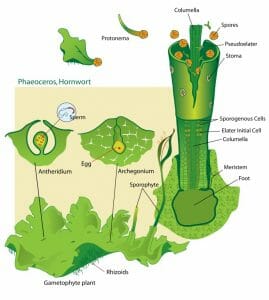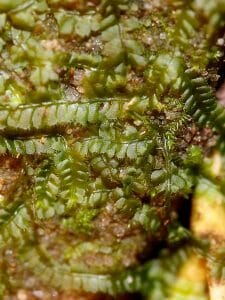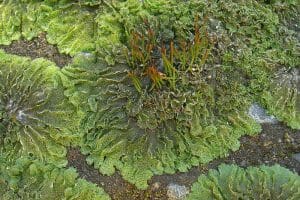Bryophyte Definition
Bryophytes are a group of plant species that reproduce via spores rather than flowers or seeds. Most bryophytes are found in damp environments and consist of three types of non-vascular land plants: the mosses, hornworts, and liverworts.
Bryophyte Characteristics
The following characteristics are exhibited by bryophytes:
- Bryophytes are non-vascular land plants. Although they do exhibit specialized structures for water transportation, they are devoid of vascular tissue.
- Bryophytes grow primarily in damp environments but can be found growing in diverse habitats ranging from deserts, the artic, and high elevations. Since bryophytes do not depend on root structures for nutrient uptake like vascular plants, they are able to survive in environments that vascular plants cannot (e.g., on the surface of rocks).
- All bryophytes have a dominant gametophyte stage in their life cycle. During this stage, the plant is haploid and the sex organs that produce the gametes are developed. Bryophytes are unique compared to many other plant species in that they remain in this stage for long periods.
- The sporophytes (the diploid form of the plant) of bryophytes are unbranched, producing a single spore-producing capsule (sporangium). Moreover, the sporophytes are dependent on the gametophyte for nutrition and develops within the female sex organ (archegonia).
Bryophyte Life Cycle
The bryophyte lifecycle consists of alternating generations between the haploid gametophyte and the diploid sporophyte. During the gametophyte stage, haploid gametes (male and female) are formed in the specialized sex organs: the antheridia (male) and archegonia (female). The gametes consist of flagellated sperm, which swim via water or are transported by insect species. The two haploid gametes (sperm and egg) fuse, a diploid zygote is formed. As described above, the zygote of bryophytes grows inside the archegonia and will eventually become a diploid sporophyte. Mature sporophytes remain attached to the gametophyte and generate haploid spores via meiosis inside the sporangium. These spores are dispersed, and under favorable environmental conditions become new gametophytes. The lifecycle is shown below.
Bryophyte Examples
The three main types of bryophytes consist of the liverworts, mosses, and hornworts, each of which encompasses several hundred different species.
Liverworts
Liverworts (shown below) are extremely small plants characterized by flattened stems and undifferentiated leaves, as well as single-celled rhizoids. Liverworts can be distinguished from other bryophyte species by the presence of membrane-bound oil bodies within their cells, compared to other species which do not contain enclosed lipid bodies.
Mosses
Mosses (shown below) are green, clumpy plants often found in moist environments out of direct sunlight. Mosses are characterized by leaves that are only one cell wide attached to a stem that is used for water and nutrient transportation. Mosses are able to absorb a substantial amount of water and have historically been used for insulation, water absorption, and a source of peat.
Hornworts
Hornworts (shown below) are named after the characteristic long horn-like sporophyte that develops. In contrast, the gametophyte form is a flat, green-bodied plant. Most hornworts are found in damp environments (e.g., tropical climates), garden soils, or tree bark.
Quiz
1. Which of the following is NOT a type of bryophyte:
A. Mosses
B. Lornworts
C. Liverworts
D. Hornworts
2. Which stage bryophytes spend the majority of the lifecycle?
A. Zygote
B. Sporangium
C. Sporophyte
D. Gametophyte
References
- Asakawa et al. (2013). Phytochemical and biological studies of bryophytes. Phytochemistry. 91:52-80.
- Medina et al. (2018). Shifts in the importance of the species pool and environmental controls of epiphytic bryophyterichness across multiple scales. Oecologia. Jan 18. doi: 10.1007/s00442-018-4066-x.
- Ohyama et al. (2009). Gene content, organization and molecular evolution of plant organellar genomes and sex chromosomes: insights from the case of the liverwort Marchantia polymorpha. Proc Jpn Acad Ser B Phys Biol Sci. 85(3):108-24.
- Shaw et al. (2011). Bryophyte diversity and evolution: windows into the early evolution of land plants. Am J Bot. 98(3):352-69.
Bryophyte




No comments:
Post a Comment